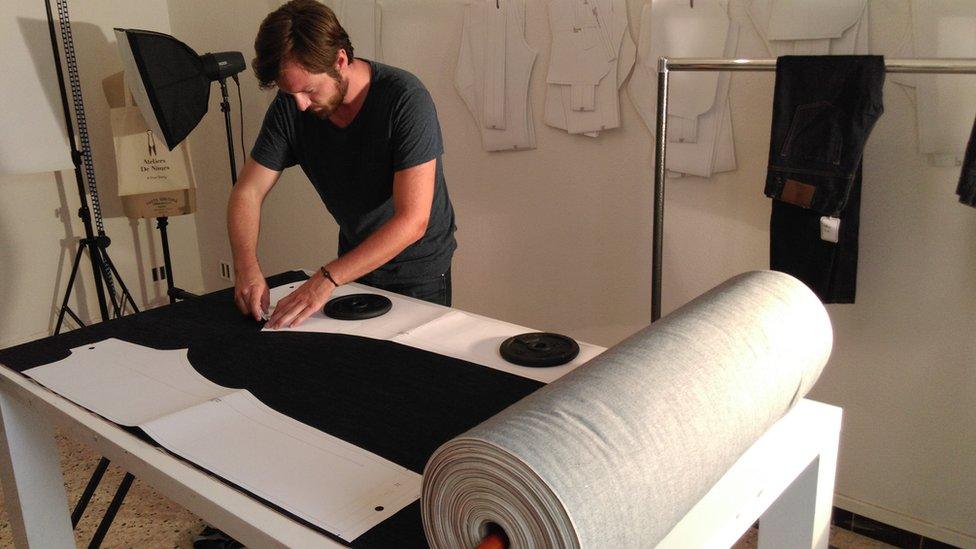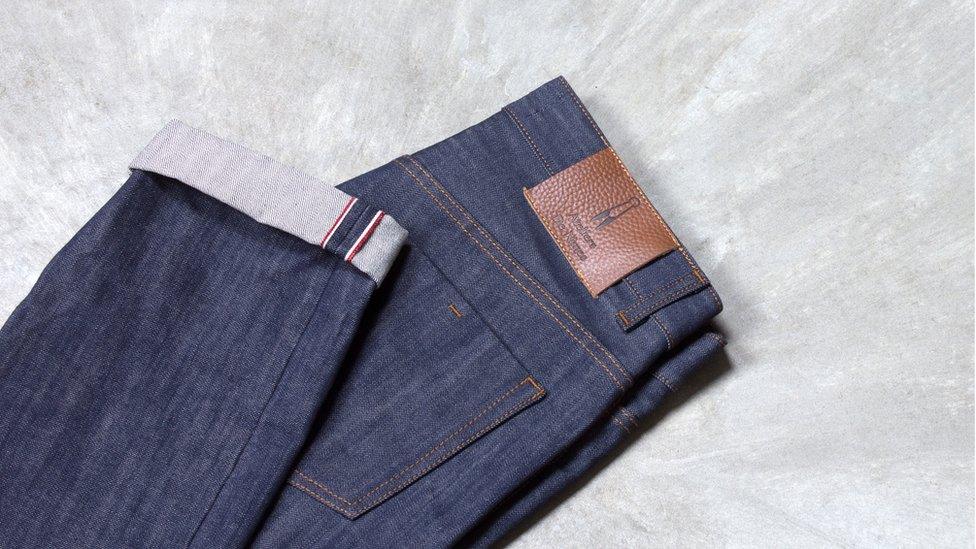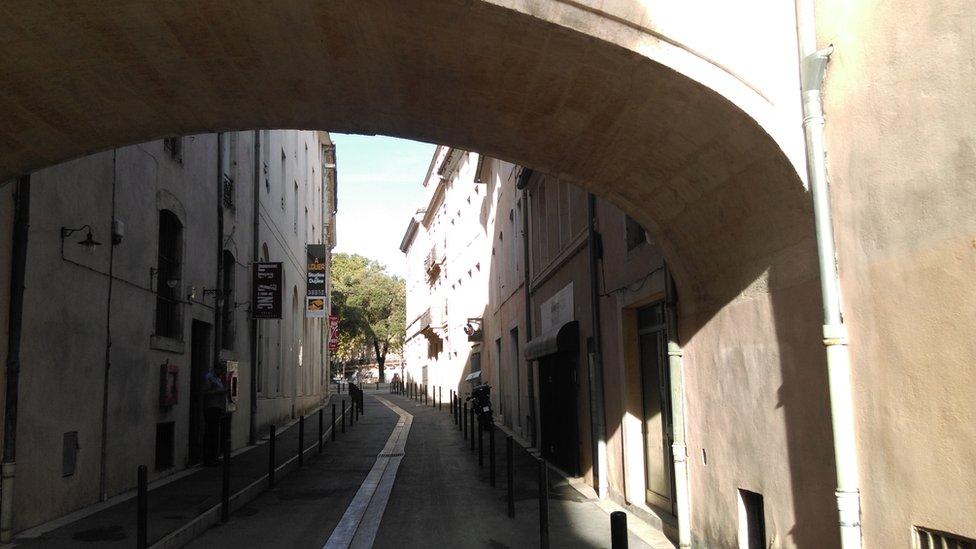How the birthplace of denim is making jeans again
- Published

Guillaume Sagot, founder of Ateliers de Nimes, in his workshop
Although jeans are often associated with North America, the material they are made from - denim - actually originates from the southern French city of Nimes. And now a small company has started making jeans in the birthplace of denim.
In his small workshop looking out on to a sun-drenched courtyard in a residential street in Nimes, Guillaume Sagot is cutting up a denim canvas with a giant pair of scissors.
The 31-year-old entrepreneur uses chalk first to draw the outline of the different jean segments before carefully cutting them to size. The cuts will then be sent to Marseille, an hour and a half's drive away, to construct pairs of jeans at a small artisanal textile factory.
Sagot started his business, Ateliers de Nimes, two years ago. The idea was simple: to make jeans in the birthplace of denim.
But in a city that no longer has a textile industry that proved difficult from the outset.
"I had to start completely from scratch," he tells me.
"There is no-one left in Nimes who can make jeans. I found a tailor in Marseille who taught me how to make them and I now do most of the work myself by hand. The factory in Marseille puts all the components of the jeans together."
The birthplace of denim
The term "denim" derives from the French "serge de Nimes", meaning "serge (a sturdy fabric) from Nimes". Yet the fabric is no longer produced anywhere in France.
Sagot therefore buys the denim canvas from the Venice region of Italy, made on an old shuttle-loom from the 1950s.

Each pair of Ateliers de Nimes jeans is hand-made and individually numbered
Nimes once had a booming textile industry. In the 18th and 19th Centuries, the city was home to large textile factories producing many different fabrics.
Thousands of people worked in textiles in the city during the height of the industry. They would crouch along the river that flowed through the streets of Nimes, dying cotton, wool and silk.
Many of these fabrics were exported to North America, including serge de Nimes, which caught the eye of businessman Levi Strauss in the 1860s. Strauss used this new fabric, re-baptised as denim, to create what became known as blue jeans.
There is little left now in the city to testify to Nimes' once thriving textile industry. The river that was used by the dyers is now underground, old factories have been repurposed, and the city's economy is now mainly service-led.

In the 18th and 19th Centuries a river ran through this street where workers would dye cotton, silk and wool
At the turn of the 20th Century, textile production in the city slowed down. Despite the popularity of denim, fashion tastes changed and demand for many of Nimes' fabrics fell. Production of denim eventually moved to cheaper locations in Europe and then Asia, and vanished from the region all together.
"The skills and expertise are starting to disappear completely now," explains Martine Nougarede, the former curator of the city's history museum who has spent the best part of her life researching the history of textile production in the city.
"There is always this nostalgia to revive the textile industry in Nimes. I don't think that's possible though. There isn't the demand for it here.
"With the advent of globalisation, textile factories have moved to places where labour is cheaper. You can't compete in terms of production and labour costs by having factories in France or even anywhere in Western Europe."
Denim dreams
Over 50% of denim is now produced in Asia, in countries such as China, India and Pakistan. The few denim mills left in Europe and North America are facing another significant challenge: the use of synthetic fibres.
In an effort to reduce costs, many manufacturers are blending cotton with polyester, and as a result denim factories are being dismantled as demand for top quality denim falls.

Martine Nougarede, does not believe it is possible to revive the textile industry in Nimes
Despite those pressures, back in his Ateliers de Nimes workshop, Guillaume Sagot remains upbeat. His ambition is to produce jeans entirely made in France, from the denim to the buttons and rivets.
"My dream is to open two factories in Nimes. One that makes denim and the other that creates jeans," he says.
But how can he remain competitive when labour and production costs are so high?
Well Ateliers de Nimes' jeans don't come cheap - the three styles on offer cost €269 (£235) each.
"The jeans are for people who really appreciate good denim, and want jeans that last and that are distinctive," Sagot explains. "Each model is hand-made and individually numbered so you know that the jeans you are wearing are unique."
Ateliers de Nimes sells its jeans online and in just over a dozen small boutiques dotted around the south of France. Sagot says he is already getting more orders from the shops and he is now working on new cuts.
So despite the huge cost of making jeans in France, it seems there is a demand for high-end artisanal jeans, but we appear to be a long way off from seeing a return of denim production and a revival of the textile industry in the south of France.
You can listen to Joshua Thorpe's report on World Business Report.